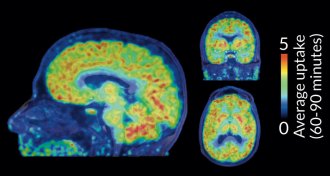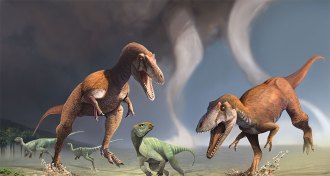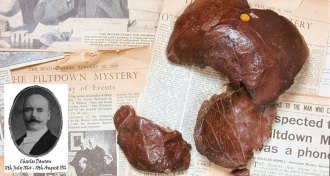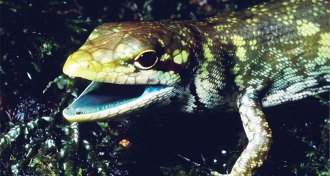All Stories
-
 Genetics
GeneticsScientists get a glimpse of chemical tagging in live brains
For the first time scientists can see where molecular tags known as epigenetic marks are placed in the brain.
-
 Paleontology
PaleontologyHumans may have taken different path into Americas than thought
An ice-free corridor through the North American Arctic may have been too barren to support the first human migrations into the New World.
-
 Physics
PhysicsThe pressure is on to make metallic hydrogen
Scientists are getting close to turning hydrogen into a metal — both in liquid form and maybe even solid form. The rewards, if they pull it off, are worth the effort.
-
 Paleontology
PaleontologyT. rex look-alike unearthed in Patagonia
A new dinosaur species discovered in Patagonia has the runty forearms of a Tyrannosaurus rex, but is not closely related to the gigantic predator.
By Meghan Rosen -
 Anthropology
AnthropologyNotorious ‘ape-man’ fossil hoax pinned on one wrongdoer
New Piltdown Man study pegs infamous ‘ape-man’ skull forgery on one well-informed culprit.
By Bruce Bower -
 Animals
AnimalsBetty the crow may not have invented her hook-bending tool trick
Textbook example of Betty the crow’s proposed insight into toolmaking is now called into question by observations of similar hook bending by wild New Caledonian birds.
By Susan Milius -
 Neuroscience
NeuroscienceAging-related protein may play role in depression
Mouse study reveals link between aging protein and depression.
-
 Environment
EnvironmentNew desalination tech could help quench global thirst
Designed with better, more energy-efficient materials, next-generation desalination plants may offer a way to meet the world’s growing need for freshwater.
-
 Particle Physics
Particle PhysicsCooling stars hint at dark matter particles
Stars that cool faster than expected can be explained by hypothetical particles called axions.
-
 Astronomy
AstronomyMagnetic fields in sun rise at 500 kilometers per hour
Magnetic fields within the sun rise up no faster than about 500 kilometers per hour, suggesting that the movement of gas is responsible for bringing these fields to the sun’s surface.
-
 Animals
AnimalsThese lizards bleed green
Blood and bones turn naturally green in island lizards. Their evolutionary history still needs explaining.
By Susan Milius -
 Particle Physics
Particle PhysicsBottom quarks misbehave in LHC experiment
Bottom quarks fly off at an angle more often than expected in new data from the LHC.